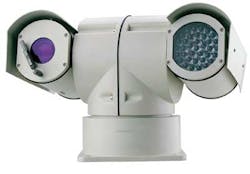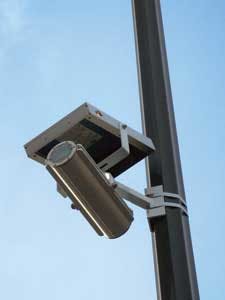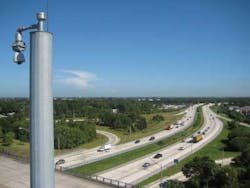LEADING EDGE VIEWS - Machine Vision Moves into Traffic: Part I
Designing a vision system for intelligent transportation applications brings with it a unique set of challenges that developers of vision systems for industrial inspection may never face. In industrial vision systems, developers can often control the manner in which parts are presented for imaging and inspection. In doing so, how parts are lit, the background, and which objects are in the camera's field of view can be somewhat controlled.
When developing an image-processing system for the intelligent transportation systems (ITS) market, however, it is often impossible to control the environment in which the imaging system operates. Engineers must deal with temperature extremes, moisture, debris, and extreme variations in lighting as well as factors such as accessibility and serviceability.
Mindful management of environment
In most ITS applications, thermal management is an important issue. Systems must operate across extreme temperature ranges and developers must control the temperature of the electronic and optical subsystems through the use of cooling fins, fans, and heaters.
Controlling the moisture in systems is also challenging. Moisture may increase the conductivity of insulators, leading to malfunction. Low humidity may make materials brittle. Regardless of the stated operating humidity range, condensation -- on the optical components, the glass windows protecting the optics, or the windows protecting the light sources in the vision system -- can also present a danger to electronic circuitry.
Like moisture, debris can present its own set of issues for designers of transportation imaging systems. Debris can take many forms, from rainwater, snow, hail, and ice, to mud and stones thrown onto a system by vehicles traveling along a highway.
There are many ways to deal with moisture and debris. Traditional approaches involve using dry air or nitrogen to purge the enclosure of a vision system during assembly, desiccants to remove moisture, and heavy-duty seals to ensure that there is no unwanted ingress of material.
Outside the enclosure, a number of techniques can be employed to ensure that the system functions optimally. Designers often make use of windshield wipers, water streams, pulsed blasts of air, and fans or blowers to ensure that the vision system can reliably capture images under all weather conditions (see Fig. 1).
The issue of debris is especially problematic in developing imaging systems where cameras must be mounted pointing upward. It is often necessary to construct bespoke guards to protect the system. These may need to be regularly washed, rinsed, windshield wiped, or air blasted during use to ensure that they are as maintenance-free as possible.
Addressing extreme lighting
The biggest difference between an industrial machine-vision system and those that operate in ITS applications is that the transportation system must operate under extreme lighting variations. For example, there are nine orders-of-magnitude variation in luminosity between the darkest night and a sunny day in a desert. Although human eyesight can cope adequately, a number of techniques must be deployed to ensure that vision systems can perform just as well.
The dynamic range of an image sensor is the ratio of the largest nonsaturating input signal to the smallest detectable input signal. In ITS applications, it is often necessary to use an imaging sensor with as wide a dynamic range as possible, but, naturally enough, the larger the dynamic range of the imager, the more expensive it may be.
Similarly, automatic exposure control, which can provide another three orders of magnitude in variation of luminosity, is almost always required. This is especially true when imaging moving objects such as automobiles; the exposure time will be dictated by the speed of the vehicle and under what lighting conditions (either day or night) the image of the vehicle is captured.
Automatic gain control is another technique that can provide another two orders-of-magnitude increase by boosting the output from the image sensor as light levels drop. When the light levels are high, the automatic gain control switches off so the boost does not cause unwanted effects like streaking.
Auto-iris lenses -- which are very rarely seen, if at all, in machine-vision applications -- are quite common in the ITS environment. Here, a camera can adjust the lens to capture the best picture given changing light levels and provide another three orders of magnitude in luminosity variation.
One further means to increase the dynamic range of such a system is to use an infrared (IR) filter designed to block IR wavelengths while passing visible light. Such IR filters can provide another factor of two in dynamic range, but because the filters cut down the amount of light that enters the camera, a mechanical changeover of the filter is required if the system operates at night.
Up the pole
Designers of vision systems for the ITS marketplace must contend with installing, maintaining, and upgrading their systems in inhospitable environments, which can be a costly proposition. Systems are often installed in remote locations or on moving vehicles, and access may be difficult due to the height of a system, its proximity to traffic, or for safety reasons.
The cost of physically employing a team to mount a camera or vision system in an appropriate location can actually be more expensive than the price of the camera or vision system. Running the electrical and communication facilities out to the vision system can be three times more expensive than installing the system itself.
Therefore, it is important to review all the means by which the costs involved in physically accessing the systems for maintenance or software upgrade purposes can be reduced prior to installation. Deploying a system that is easy to install and operate may provide system integrators with a considerable edge over their competitors.
Of course, hardware and software issues must be considered. System designers can employ mechanical winching systems (see Fig. 2) that enable cameras to be lowered to the ground, reducing maintenance expenses. To reduce wiring complexity, developers can take advantage of battery-powered, solar, solar- and wind-powered systems, or propane or gasoline generators that will enable their transportation imaging system to perform in an uninterrupted fashion year round (see Fig. 3). Such systems also have the advantage that they can be installed in locations that may previously have been classed as too far away from the power grid.
Engineers can also employ smart-camera-based systems that can be interrogated via wireless links, a potentially less expensive option than hard-wiring. Wireless systems can also diminish the complexity involved in performing regular software updates, especially if they can be conducted by an operator using a handheld wireless communication unit such as a smart phone.
Finally, any system integrator should be aware that installing any vision system for transportation imaging applications will involve obtaining civil engineering planning permits and approvals, and delays in gaining both must be taken into account.
In Part II of this three-part series, Dr. Ned Lecky from Voyant Vision will provide an overview of the image-processing software that is used in the intelligent transportation system (ITS) marketplace.




